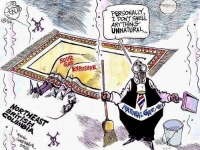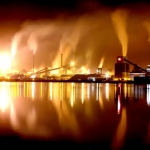The Smell of Money: British Columbia's Gas Rush

British Columbia -- Spring has yet to come to the Peace River region, but signs of growth are everywhere. On the steppes of northeastern British Columbia, places with frontier names like Tumbler Ridge, Dawson Creek, and Fort St. John are part of a mining boom that is giving towns an economic boost for the first time in twenty years. The rush is not for coal or gold, but natural gas -- and plenty of it.
Since NAFTA went into effect in 1993, Canada has quietly become the largest exporter of oil and gas to the United States. Canadian exports now account for roughly 15% of natural gas and 9% of crude oil flowing into the U.S. These figures continue to climb as demand keeps rising south of the border.
From ExxonMobil to Talisman, Shell, and EnCana, the region now hosts the giants of oil and gas. With more than 100 companies competing for profit and 10,000 gas wells already on-line, production is advancing north along the Alaska Highway to Fort Nelson and southwest toward Alberta, where wells share canola and barley fields with farmers who have little control over where and when new wells are drilled.
Though still smaller than the untaxed black-market marijuana crop, oil and gas -- not timber -- is now British Columbia's sweetheart resource. The number of wells in the province grew 39% over the last decade, creating a five billion dollar industry that the conservative Liberal Party says it wants quadrupled by 2008.
For most of a decade, Alberta was the place to be if you wanted to join the rush. But in Tumbler Ridge, as in many places in British Columbia, municipal officials have auctioned every available lot for the garages and equipment dealers needed to service industry. Property values have already more than doubled. There is talk of building a first class hotel to house executives when they pass through town. And once production begins no less than 1000 workers will be needed to operate the wells, drive the trucks, service the lines, haul water and flare the stacks.
Sour Gas
Gold miners say that gold produces a fever. Spend one hour walking through a gold rush town and you start having feverish fantasies of pulling together enough money for a missile dredge and a crew. And if gold has a fever, then natural gas has an odor. At least half of the gas reserves exhumed from the deep in this part of the world are sour. Sour gas is rich in sulphur and surfaces in a toxic compound with hydrogen. It emits the unmistakable scent of foul eggs, similar to the fumes around refineries.
Driving from town to town, dense daytime air gives way to darkness punctuated by flares shimmering like beacons from one ridge to the next. Standard practice in the industry is to "dispose" of hydrogen sulphide by burning it on site rather than paying to pipe it to a refinery, have it separated, and find a market for it. (Flared hydrogen sulphide also becomes sulphur dioxide, or SO2.)
When inhaled in doses of more than 100 parts-per-million hydrogen sulfide attacks the respiratory system, killing you in a matter of seconds. If you are lucky, the concentration is only half that, and causes what oil and gas workers call a "knockdown," that makes unprotected well operators who stumble into leaks instantly collapse from the toxicity. Routine, lower-level exposure causes neurological damage including memory loss, headaches and dizziness and reproductive disorders like miscarriages and birth defects, and -- depending on whom you ask -- cancer.
Potential Health Risks
Despite more than a century of experience from which to draw answers about sour gas, most questions, especially its carcinogenicity, remain fuzzy to the scientific community -- not because the science is in conflict but because it simply is not there. According to the Agency for Toxic Substances and Disease Registry, "Hydrogen Sulfide has not been classified for its ability to cause or not cause cancer." Similarly, the U.S. EPA concludes that data are inadequate for an assessment of the carcinogenic potential of hydrogen sulphide.
For industry, the lack of scientific data is justification for exploitation rather than cause for caution. "We take the threat of sour gas very seriously," says Jan Rowley, Shell Canada's Manager of Public Affairs. "There is no doubt hydrogen sulphide is a deadly poison. But when it gets to low concentrations there are questions," she explained.
"So far there has not been anything that confirms the concerns of residents, and there are lots of studies which demonstrate that workers' exposure over 50 years failed to result in ill health effects," Rowley asserts.
What is known, however, is that in the last two years at least two workers have died in the BC Peace River region from sour gas. Meanwhile, the Workers Compensation Board estimates there are four to five "known" knockdowns per year -- a number that is almost certainly low because of a heavy code of silence respected within the industry, according to labor activists. Nevertheless, they still find even this estimate shocking.
"That is an outrageous figure," says Mae Burrows, Director of the Labour-Environmental Alliance. "I don't know any other industry where that level of insult to workers is tolerated so openly." Indeed, the National Institute for Occupational Safety and Health deems sour gas the most common cause of sudden death in the workplace.
Industry Operates with Impunity
Despite these immediate public health and labor concerns, the provincial government is blowing full-steam-ahead with plans to exploit natural gas while the investment climate is in its favor. Canadian resource extraction is governed by archaic 19th century mining laws that refuse landowners rights to anything below six-inches of Earth's surface. In short, the provincial government, not local residents, is the primary beneficiary of billions in royalties from deeply buried natural gas deposits.
By slashing the enforcement capacity of environmental agencies in half, government has swiftly transformed the Peace Region into a who's-who of the fossil fuel industry, operating with few regulatory obstructions in a manner decidedly reminiscent of third-world industrial development.
"Industry just does whatever it wants," says Stacey Lajeunesse, who is board director for the Peace Country Environmental Protection Association, a citizens group founded in 1994. "Industry has the money to convince people that there isn't a problem, and public health is a low priority for the provincial government. There's nobody out in the backcountry to watchdog this stuff."
Communities in Jeopardy
It used to be that wells were sunk in the bush, more or less away from populated areas. But the convenience of drilling next to people's homes, where access to roads, power, and water reduces start-up costs, has companies sinking wells so close to residences the noise of compressors and smell of flared gas are now constant companions to daily life. Although industry and government both talk about new technologies for gas exploration that have minimized the potential of disaster, people remain at risk from both long-term low-level and catastrophic exposure from leaks, explosions, and routine flaring.
"The way the law is currently structured in British Columbia sour gas wells can be drilled within 100 meters of private homes," says Karen Campbell, staff lawyer for West Coast Environmental Law. "This is a real concern for residents, who have very little opportunity to participate in decisions about drilling on or next to their homes. Even the Oil and Gas Commission's own Advisory Committee has expressed concern about the lack of legal requirements with respect to the placement of sour gas wells," she noted.
Families describe the terror of feeling their houses shaken by an explosion at the nearby well, grabbing their children from bed, and dashing to their trucks as the stink of sulphur envelopes them. Others speak to the fear of carrying infants to term with a sour well operating in spitting distance of their homes, and the constant concern of what the poisons are doing to their children.
"I don't know what it's going to take for people to wake up to what's happening here," a local woman told me, throwing her hands to the air in exasperation. "We're even scared to grow a garden because we don't want to eat food from our land. We don't have any idea what's in the soil."
Local Residents Worn Down
Initially, this story followed the plight of these families whose lives are in ruin because of sour wells perched in view of their kitchen windows. It documented their health woes, their trouble getting physicians to take them seriously, and their feelings of abandonment. Quickly it became a first-hand report meant to circulate on a limited basis to environmental groups. But as time went on, one by one my sources dropped away. One couple, who had sought me out to discuss burns on their bodies suffered after what they believed was an unpublicized leak at a nearby well, stopped talking. Another family simply decided they were tired of telling their story.
The story is not easy to report. In similar situations, when whistleblowers start talking to journalists or environmentalists about compensation for health and property damage, companies have been quick to arrive on the scene offering cash settlements in exchange for non-disclosure agreements. Or, somebody who refuses to sign a non-disclosure agreement may find themselves promptly deserted by once-friendly neighbors. They then watch as the government plucks away at disquiet by hiring distressed residents in order to quench their outrage, and is finally intimidated by companies with threats of expensive legal action.
In fact there is no way to assess how many knockdowns occur each year, how many residents are sick, or even how many people are killed from sour gas. "The government's own compliance reviews are much less comprehensive than they used to be. This calls into question whether we can even track compliance with the oil and gas laws that do exist," says attorney Karen Campbell.
One frustrated resident told me, "Look, I want to talk to you, but I've been shouting about this for five years, and no good has come of it. I can't afford to pay a lawyer if it comes to that. I just want to sell my land and get my family out of here."
Extreme Choices
If history is any indication, government is bound to wind-up with its hands full. On the cusp of the millennium, sour gas on the Alberta side of the Peace River led to Canada's most emotionally charged individual protest against oil and gas expansion. Before landing in prison for two years, Wiebo Ludwig, his family, and small community of renegade fundamentalist Christians, fought companies over their right to drill sour gas on his land. The spiraling tragedy found Ludwig sabotaging wells, two people dead, and the Royal Canadian Mounted Police collaborating with oil companies to stage acts of terrorism on their own wells in hopes of framing the fundamentalist.
Largely because of the paperback publication of an award-winning book by journalist Andrew Nikiforuk, this story is only just beginning to circulate on the BC side of the Peace River, where the Ludwigs operate a successful drywalling business. And it is common to hear Wiebo praised by residents of Dawson Creek or Fort St. John, whose sympathy for him runs deeper than respect for his plastering. "He's not crazy like they made him out to be," a woman from Dawson Creek insists. "Wiebo was framed by the police and the media to look like a lunatic. He's a fundamentalist, for sure, but he was made to look crazy."
British Columbia is still beautiful. The air is often sweet, local residents are basically at peace. But if you drive through the darkness and stare into the flares with the right kind of eyes, reality sets in that there is neither judge nor justice at work here. The cosmetic signs of progress are there -- expensive trucks cruising concrete highways and parking diagonally at KFC. But local residents must choose between long-term suffering or fleeing their homes and becoming refugees of the oil and gas rush.
This is not only a story about the ecological consequences of a natural gas boom: it is also about a human rights failure that has people feeling violated, afraid, defenseless, and humiliated. And the unanswered question is not what will scientists eventually discover about sour gas, but how will people eventually respond to the feeling that they have been abandoned?
"Our back has been pushed so far against the wall, I can see how Wiebo would do what he did," one resident tells me. "We've become a very submissive society where companies get to police themselves, and this kind of treatment is accepted. But there's gotta be more Ludwigs coming out of the woodwork."
Shefa Siegel is a freelance writer, and research consultant for environmental and indigenous groups. He is also head marketing writer for the 1310Vancouver Film School, and is currently working on a collection of stories about family, aging, and illness.



